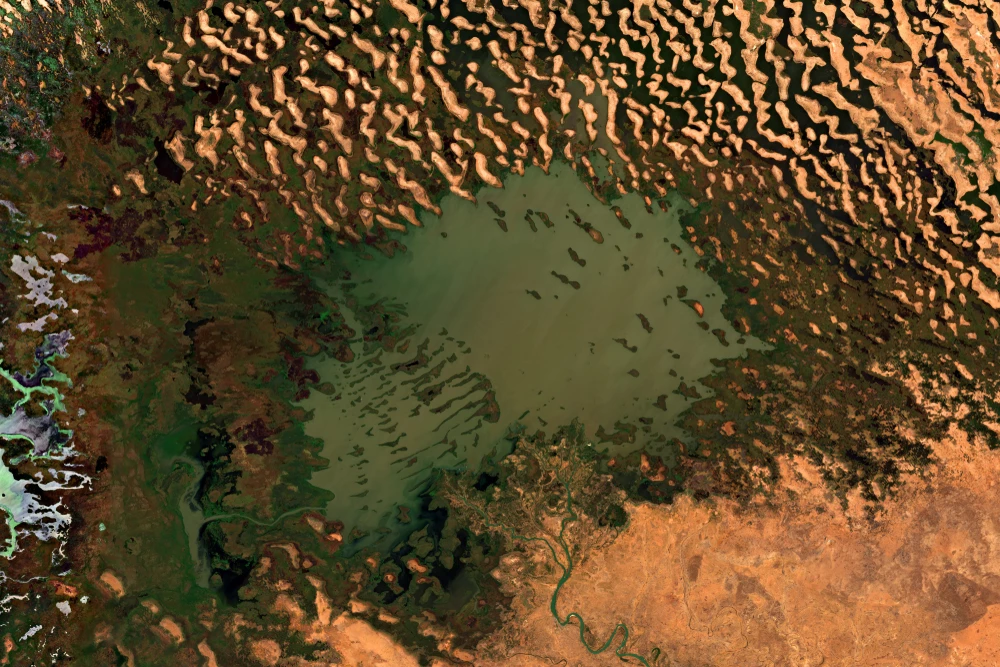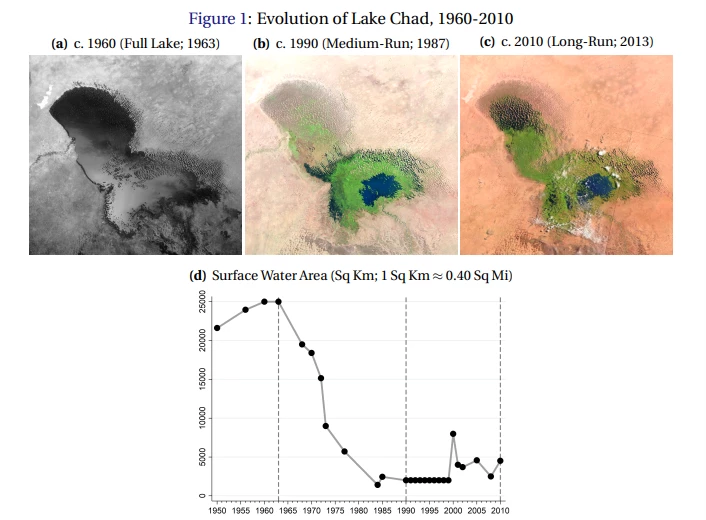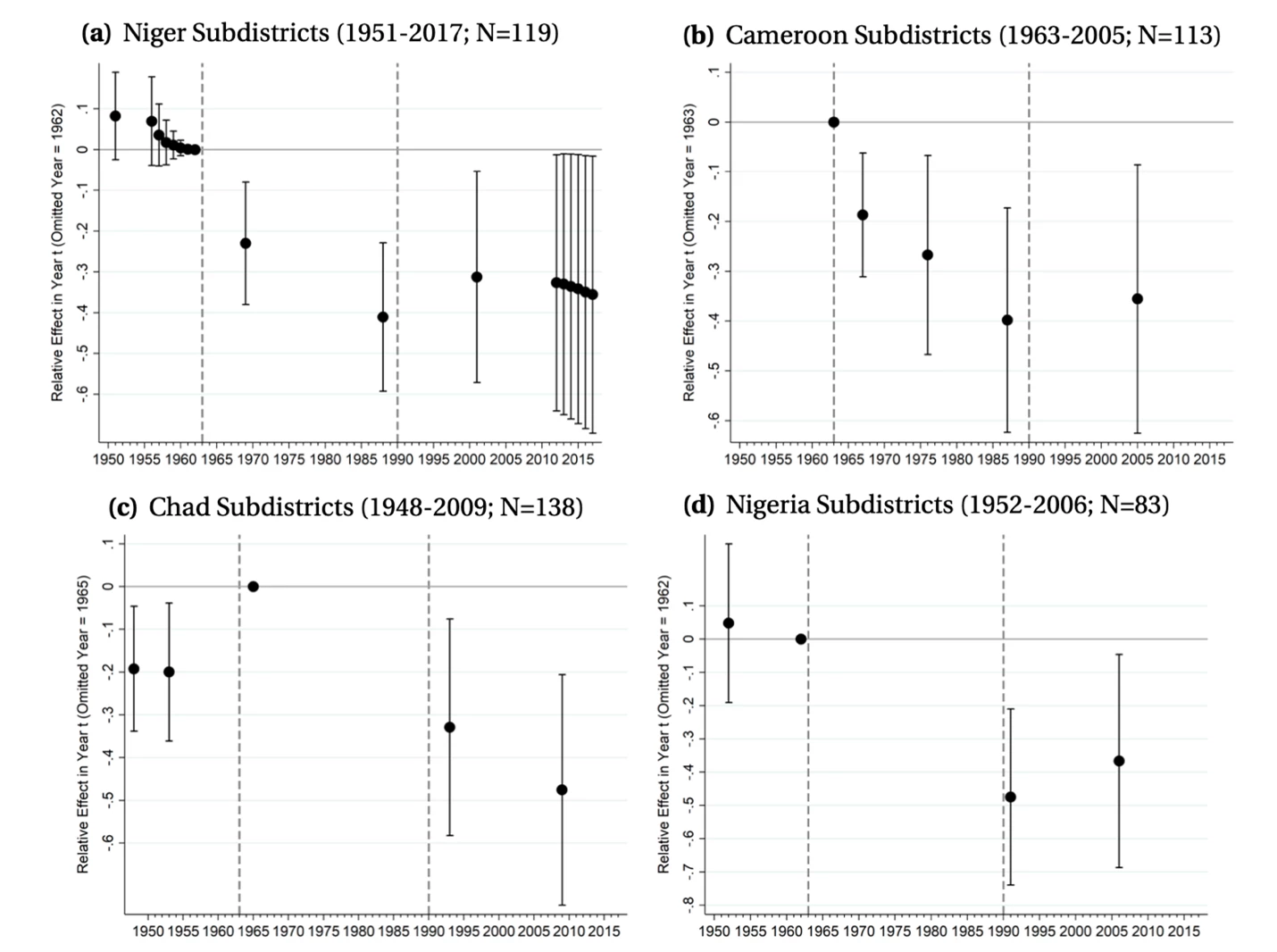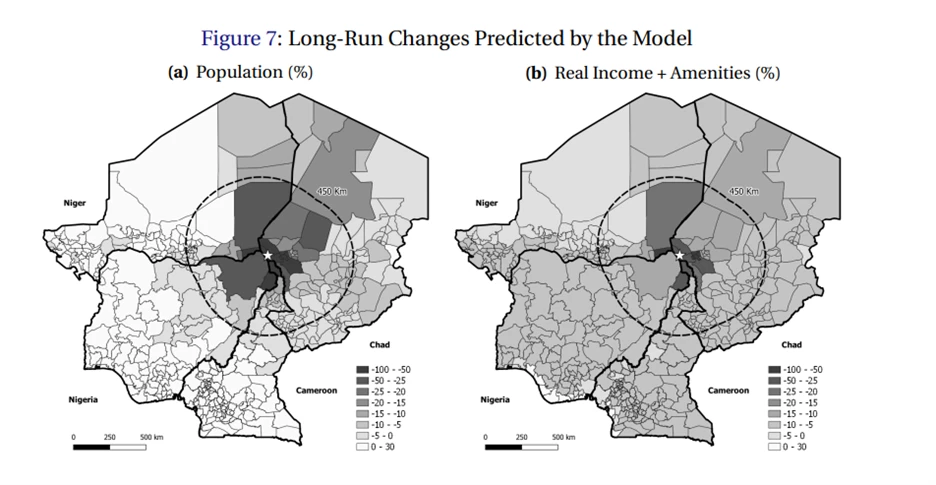
What are the development impacts of a slow, but permanent change in geography? While much attention is given to the immediate effects of climate anomalies, the gradual, yet profound, alterations in geographical conditions and their socioeconomic ramifications are also key elements to consider.
In a recent World Bank paper, researchers Roman D. Zarate, Remi Jedwab, Federico Haslop, and Carlos Rodríguez-Castelán explore this question focusing on four countries bordering Lake Chad: Cameroon, Chad, Niger, and Nigeria. Specifically, the paper assesses the drastic shrinkage of Lake Chad, historically the 11th largest lake in the world, which has lost 90 percent of its surface area between 1963 and 1990. The geographic focus in this paper is significant as Africa is the continent most vulnerable to climate change. In recognition of the significance of this research, the paper received the 2024 IZA Award for “Innovative Research in the Economics of Climate Change” (IRECC).
Lake Chad’s shrinkage occurs against a backdrop of escalating water demand, increasing scarcity, growing uncertainty, and greater weather extremes. Both climate change and global population growth are adding to strains on water use and water supply. Estimates show that with current practices, the world will face a 40 percent shortfall between forecast demand and available supply of water by 2030, which means that understanding the dynamics of water availability is more important than ever.
What does the shrinkage of Lake Chad look like? And what caused it?
Consider a body of water equivalent in size to El Salvador, Israel, or Massachusetts diminishing by a staggering 90 percent over the span of three decades. Such was the fate of Lake Chad between 1963 and 1990. The shrinkage of the lake beginning in 1963 was primarily due to reduced rainfall in the Central African Republic (CAR), a country located more than 800 kilometers (or 500 miles) away from the lake itself. This is because two major rivers – the Chari and the Logone – flow from the CAR through Chad and into Lake Chad, which acts as a sink for these rivers. Once ranked as the 11th largest lake in the world, Lake Chad now stands as an example of the permanent impacts of climate change on our planet's geographical features.
 Figure 1: In images (a) to (c), the shrinkage of Lake Chad is shown using satellite images. Image (d) graphs the surface water level of Lake Chad from 1950 to 2010.
Figure 1: In images (a) to (c), the shrinkage of Lake Chad is shown using satellite images. Image (d) graphs the surface water level of Lake Chad from 1950 to 2010.
What was the impact of Lake Chad’s shrinkage on population growth?
Tracking population patterns around Lake Chad from the 1940s to the 2010s reveals a concerning trend: areas near the lake experienced significantly slower population growth, especially after the onset of its decline. Even two decades after the shrinkage stopped, the impacts endured. Chad, being the country most heavily reliant on Lake Chad's shoreline, experienced pronounced losses.
The paper finds that the negative population impacts were stronger for rural residents, indicating that the population decrease was largely driven by decreases in this group. Rural communities often rely heavily on the lake for economic activity, making them more vulnerable to its decline. Given Chad and Niger's relatively lower levels of urbanization, their economies were disproportionately exposed to the adverse effects of Lake Chad's shrinkage. When compared to locations farther from the lake, the research indicates that over the long term, Chad experienced a 45 percent slower population growth, while other countries bordering the lake experienced a 30 percent slower population growth.
 Figure 2: Graphs (a) to (d) show the relative total population effects of proximity to Lake Chad for each country. The effect on the economy is relative to the omitted year shown on the left.
Figure 2: Graphs (a) to (d) show the relative total population effects of proximity to Lake Chad for each country. The effect on the economy is relative to the omitted year shown on the left.
What was the effect of Lake Chad’s shrinkage on the nearby economy?
Lake shrinkage, in theory, can have ambiguous effects because potentially valuable land becomes available as the water recedes. In the case of Lake Chad, despite the increased land availability, the adverse economic effects on key sectors such as fishing, farming, and herding outweigh any positive effects.
Overall, shrinkage of Lake Chad has led to a significant negative impact on the economy, with far-reaching implications for the regions bordering the lake. This decrease in welfare, estimated at approximately 6 percent, encompasses various sectors crucial for local livelihoods. While the losses are estimated to be 6 percent for the region, it is as high as 9 percent in Chad – the most negatively impacted country. The consequences of this shock extend beyond mere economic losses; they also impact the overall welfare and resilience of communities reliant on Lake Chad's resources.
 Figure 3: Due to the lake's shrinkage, the researchers estimate the impact has been a 6 percent welfare loss in the region.
Figure 3: Due to the lake's shrinkage, the researchers estimate the impact has been a 6 percent welfare loss in the region.
What about adaptation?
An examination of adaptation among communities impacted by Lake Chad’s shrinkage reveals a sobering reality: despite the profound upheaval wrought by the shrinking of Lake Chad, the evidence for adaptation is limited. In the context of the world at large, the findings of this study are particularly concerning considering the new World Development Report findings that climate change is exacerbating other drivers of human migration.
The shrinkage of Lake Chad is emblematic of a greater pattern of human movement and development. It's estimated that water deficits contribute to 10 percent of the increase in global migration among over 1 billion migrants worldwide. As climate change becomes a greater question around the world, the effects of geographical change can be lasting and significant. The persistence of adverse effects on the region underscores the urgent need for targeted interventions and support mechanisms to bolster resilience among those impacted.


Join the Conversation